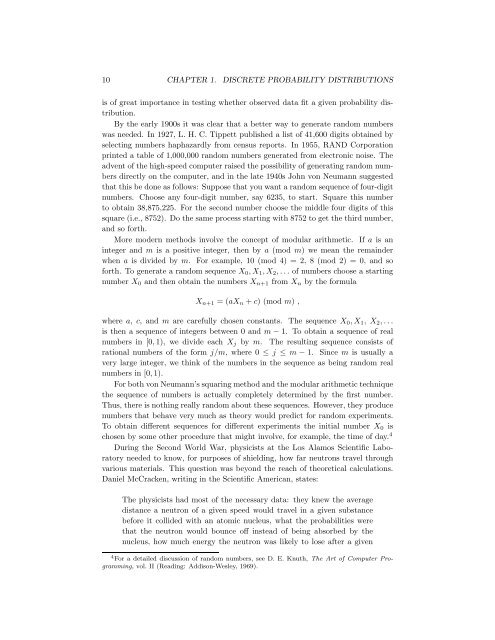Chapter 1 Discrete Probability Distributions - DIM
Chapter 1 Discrete Probability Distributions - DIM
Chapter 1 Discrete Probability Distributions - DIM
- No tags were found...
You also want an ePaper? Increase the reach of your titles
YUMPU automatically turns print PDFs into web optimized ePapers that Google loves.
10 CHAPTER 1. DISCRETE PROBABILITY DISTRIBUTIONSis of great importance in testing whether observed data fit a given probability distribution.By the early 1900s it was clear that a better way to generate random numberswas needed. In 1927, L. H. C. Tippett published a list of 41,600 digits obtained byselecting numbers haphazardly from census reports. In 1955, RAND Corporationprinted a table of 1,000,000 random numbers generated from electronic noise. Theadvent of the high-speed computer raised the possibility of generating random numbersdirectly on the computer, and in the late 1940s John von Neumann suggestedthat this be done as follows: Suppose that you want a random sequence of four-digitnumbers. Choose any four-digit number, say 6235, to start. Square this numberto obtain 38,875,225. For the second number choose the middle four digits of thissquare (i.e., 8752). Do the same process starting with 8752 to get the third number,and so forth.More modern methods involve the concept of modular arithmetic. If a is aninteger and m is a positive integer, then by a (mod m) we mean the remainderwhen a is divided by m. For example, 10 (mod 4) = 2, 8 (mod 2) = 0, and soforth. To generate a random sequence X 0 ,X 1 ,X 2 ,... of numbers choose a startingnumber X 0 and then obtain the numbers X n+1 from X n by the formulaX n+1 =(aX n + c) (mod m) ,where a, c, and m are carefully chosen constants. The sequence X 0 ,X 1 ,X 2 ,...is then a sequence of integers between 0 and m − 1. To obtain a sequence of realnumbers in [0, 1), we divide each X j by m. The resulting sequence consists ofrational numbers of the form j/m, where 0 ≤ j ≤ m − 1. Since m is usually avery large integer, we think of the numbers in the sequence as being random realnumbers in [0, 1).For both von Neumann’s squaring method and the modular arithmetic techniquethe sequence of numbers is actually completely determined by the first number.Thus, there is nothing really random about these sequences. However, they producenumbers that behave very much as theory would predict for random experiments.To obtain different sequences for different experiments the initial number X 0 ischosen by some other procedure that might involve, for example, the time of day. 4During the Second World War, physicists at the Los Alamos Scientific Laboratoryneeded to know, for purposes of shielding, how far neutrons travel throughvarious materials. This question was beyond the reach of theoretical calculations.Daniel McCracken, writing in the Scientific American, states:The physicists had most of the necessary data: they knew the averagedistance a neutron of a given speed would travel in a given substancebefore it collided with an atomic nucleus, what the probabilities werethat the neutron would bounce off instead of being absorbed by thenucleus, how much energy the neutron was likely to lose after a given4 For a detailed discussion of random numbers, see D. E. Knuth, The Art of Computer Programming,vol. II (Reading: Addison-Wesley, 1969).
















